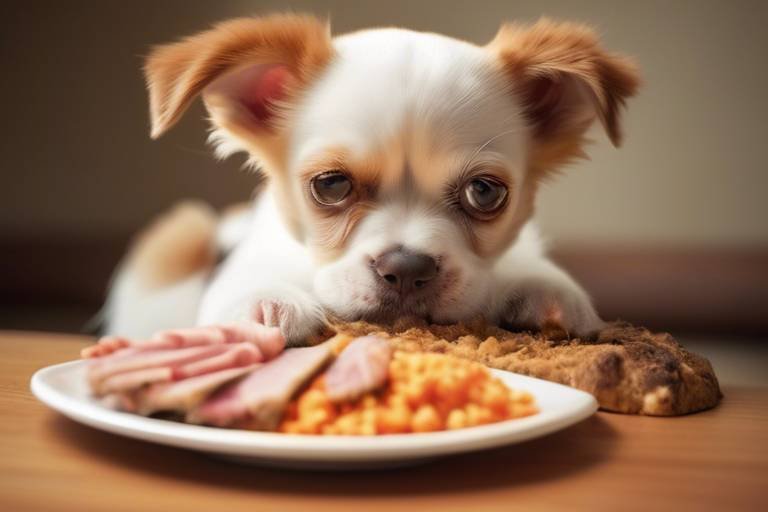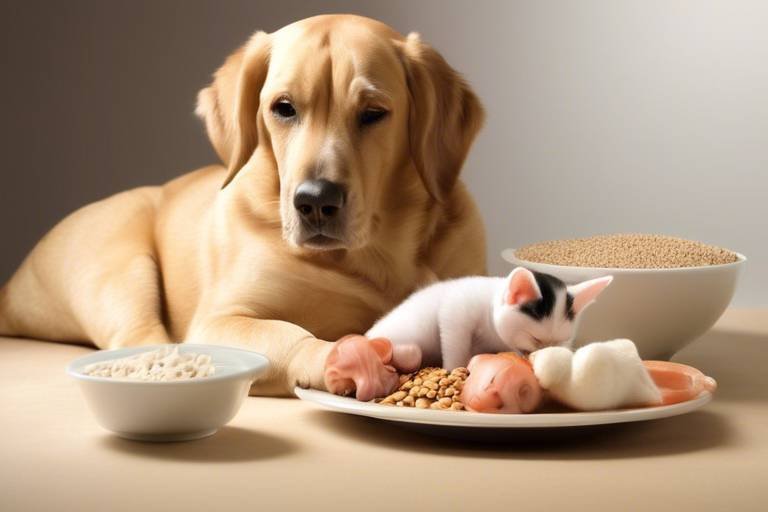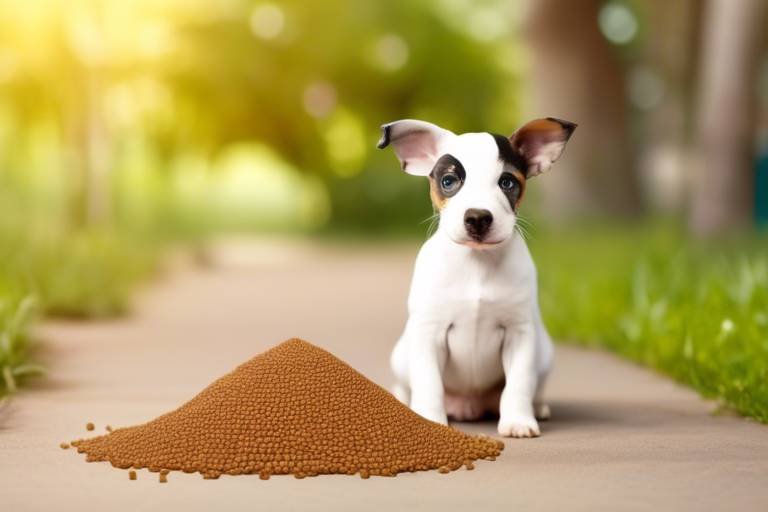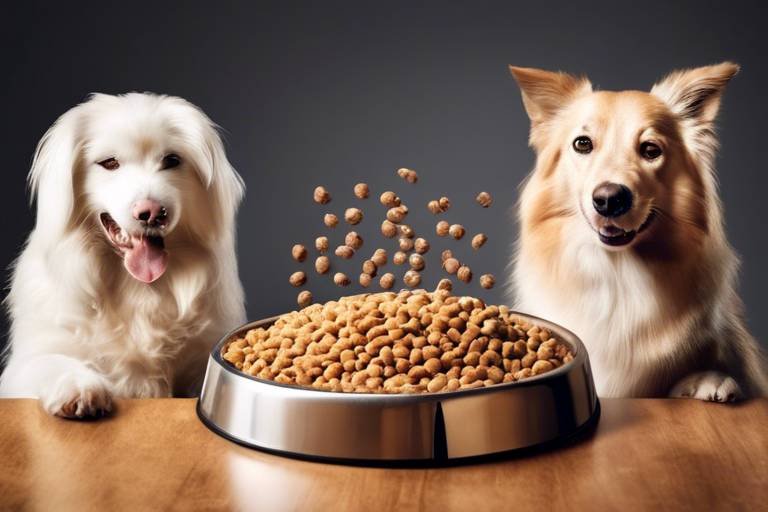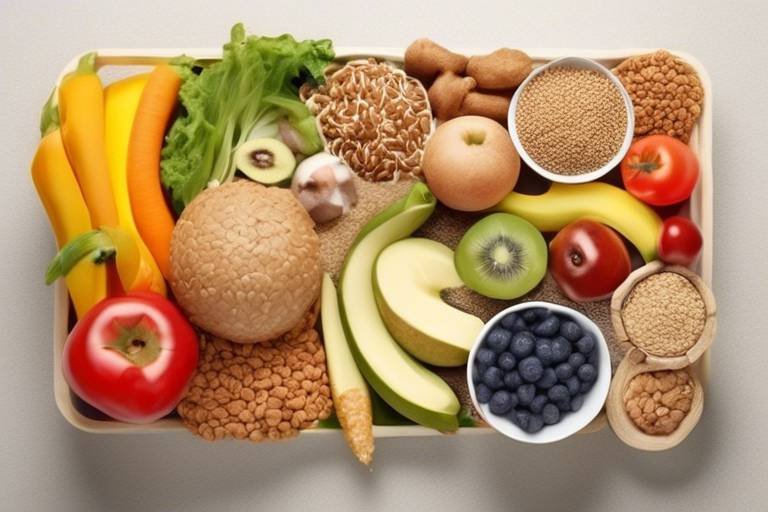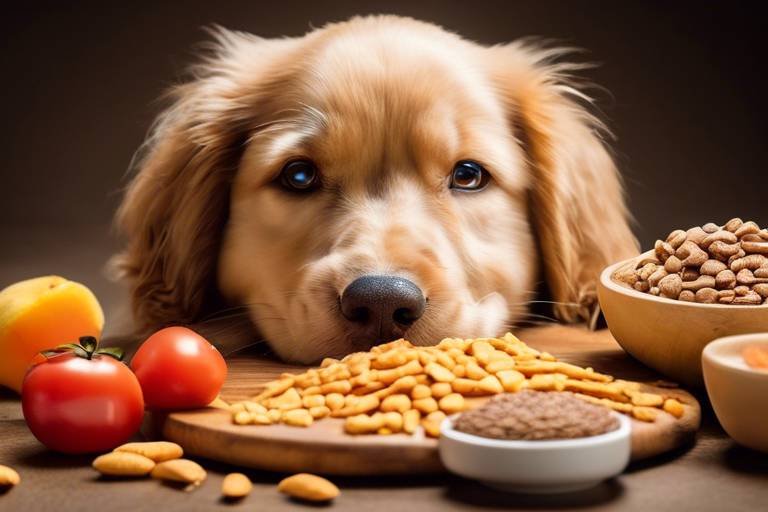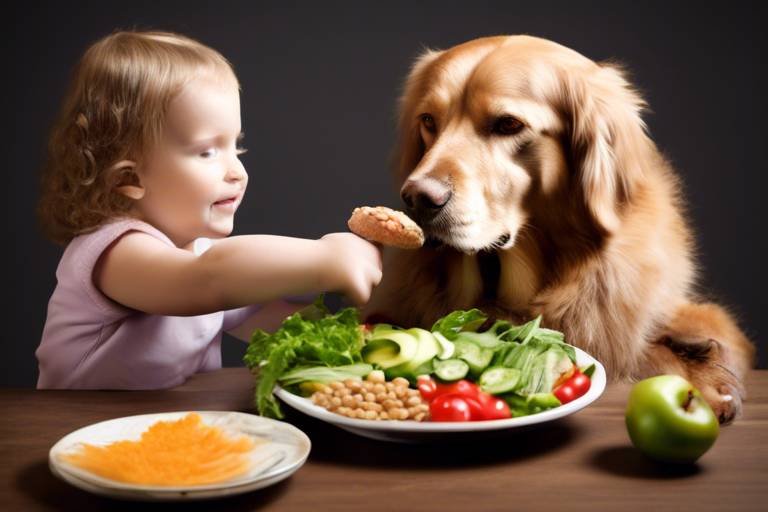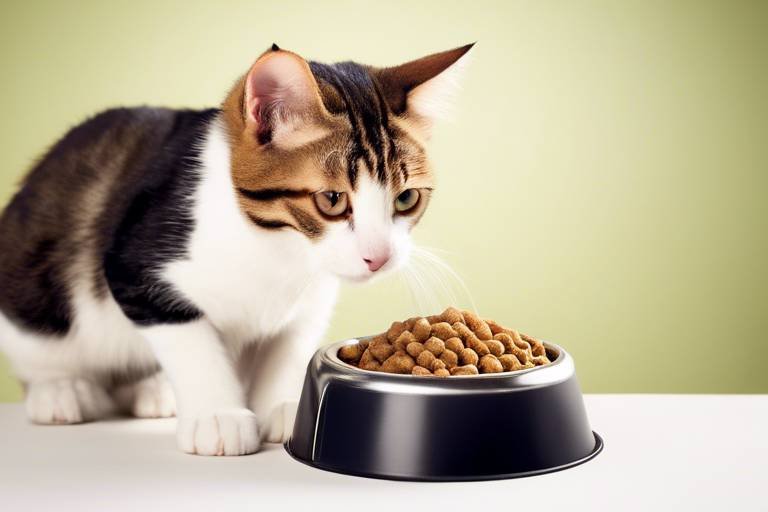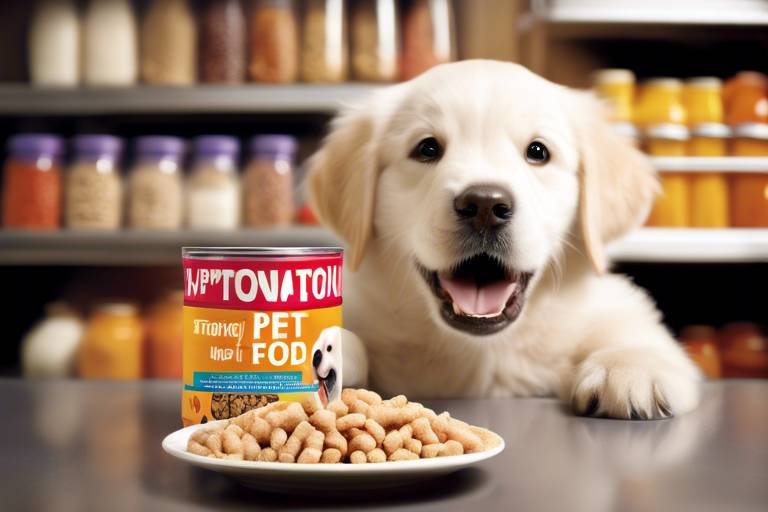The Importance of Regular Dietary Adjustments for Pets
When it comes to our furry companions, their health and happiness are often at the forefront of our minds. Just like us, pets experience changes in their nutritional needs throughout their lives. This makes regular dietary adjustments not just important, but essential for their overall well-being. Imagine trying to fit into your favorite jeans after a few years without adjusting the waistband—it's not going to work! Similarly, our pets require tailored nutrition to thrive as they grow and age.
As pet owners, we have the responsibility to ensure our pets are receiving the right nutrients at the right time. This means understanding that what worked for them as a playful puppy or a curious kitten may not suffice when they become adults or seniors. With the right dietary changes, we can help prevent health issues, maintain a healthy weight, and support their energy levels. It’s like giving them a customized health plan that evolves with them!
One of the key benefits of adjusting your pet's diet regularly is the prevention of obesity. Did you know that obesity is one of the most common health problems in pets today? It can lead to serious health complications such as diabetes, joint issues, and even heart disease. By keeping an eye on your pet's weight and adjusting their food intake accordingly, you can help them live a longer, healthier life. Just think of it as a proactive approach—like getting regular check-ups for yourself!
Moreover, dietary adjustments can also cater to specific life stages. Puppies and kittens have different nutritional needs compared to adult or senior pets. For instance, their growing bodies require more protein and calories to support development. On the other hand, senior pets may benefit from diets lower in calories but rich in nutrients that support joint health and cognitive function. It’s all about giving them what they need when they need it most!
In conclusion, regularly adjusting your pet's diet is crucial for their health and happiness. It’s not just about filling their bowls; it’s about ensuring they are receiving the right balance of nutrients tailored to their unique needs. So, the next time you’re at the pet store, take a moment to consider whether your furry friend’s diet is still serving them well. After all, a well-fed pet is a happy pet!
- How often should I adjust my pet's diet? Regular adjustments should be made based on your pet's life stage, weight changes, and health status. Consult with your veterinarian for personalized recommendations.
- What are the signs my pet needs a dietary change? Look out for weight gain or loss, changes in energy levels, or digestive issues. These can all indicate that it's time to rethink their diet.
- Are grain-free diets necessary for all pets? Not necessarily. While some pets may benefit from grain-free options, many do well on traditional diets. Always assess your pet's individual needs.
- Can I switch my pet to a raw diet? A raw diet can be beneficial but comes with its own set of risks. It's crucial to consult your veterinarian to ensure it meets all nutritional requirements.
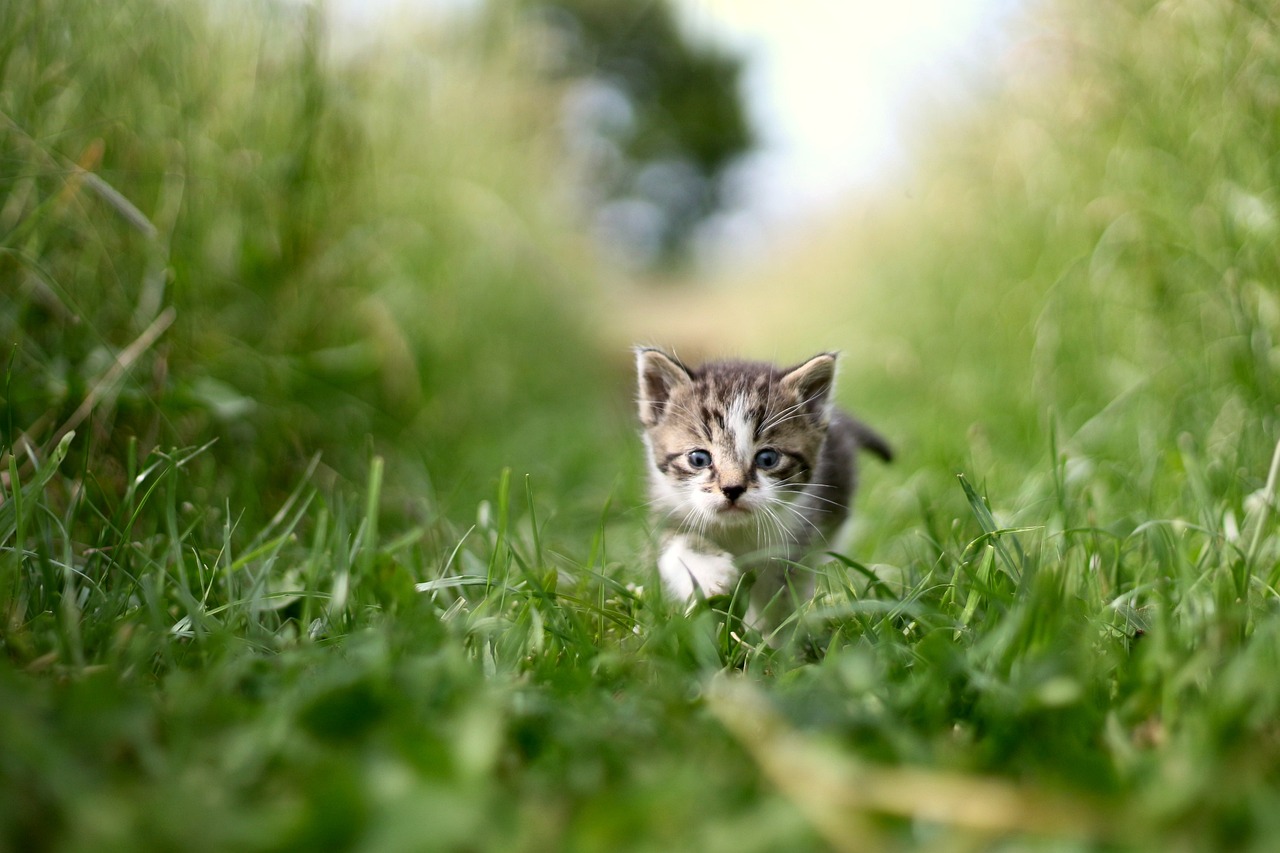
Understanding Pet Nutrition
When it comes to our furry companions, understanding pet nutrition is like having a secret key to their health and happiness. Just like us, pets require a balanced diet to thrive, and as a pet owner, it's your responsibility to ensure they receive the right nutrients. But what does that really mean? Well, let’s break it down!
First and foremost, pet nutrition isn't one-size-fits-all. Every pet is unique, just like their dietary needs. Factors such as age, breed, activity level, and even health conditions play a significant role in determining what your pet should eat. For instance, a playful puppy has different nutritional requirements compared to a senior dog who prefers lounging on the couch. This is why understanding your pet’s specific needs is crucial.
Moreover, pet food typically consists of several key components:
- Proteins: Essential for growth, repair, and overall health.
- Fats: Provide energy and support cell function.
- Carbohydrates: Offer energy and aid in digestion.
- Vitamins and Minerals: Crucial for various bodily functions and maintaining a strong immune system.
Reading pet food labels can be daunting, but it's an essential skill for any responsible pet owner. Look for high-quality ingredients and avoid fillers or artificial additives. A good rule of thumb is to choose a food where the first ingredient is a named protein source, such as chicken or beef. This ensures that your pet is getting the nutrition they deserve.
Additionally, it’s important to consider the life stage of your pet. Puppies and kittens require more calories and nutrients to support their rapid growth, while adult pets need a balanced diet to maintain their health. Senior pets may benefit from diets that are lower in calories but higher in fiber to aid digestion. Tailoring your pet's diet to their life stage can significantly impact their overall well-being.
Lastly, don't forget about hydration! Fresh, clean water should always be available to your pet. Water plays a vital role in digestion, nutrient absorption, and temperature regulation. Dehydration can lead to serious health issues, so make sure your pet is staying hydrated, especially during hot weather or after exercise.
In conclusion, understanding pet nutrition is not just about choosing the right food; it’s about recognizing the individual needs of your pet and adjusting their diet accordingly. By being proactive and informed, you can help your furry friend live a longer, healthier life.
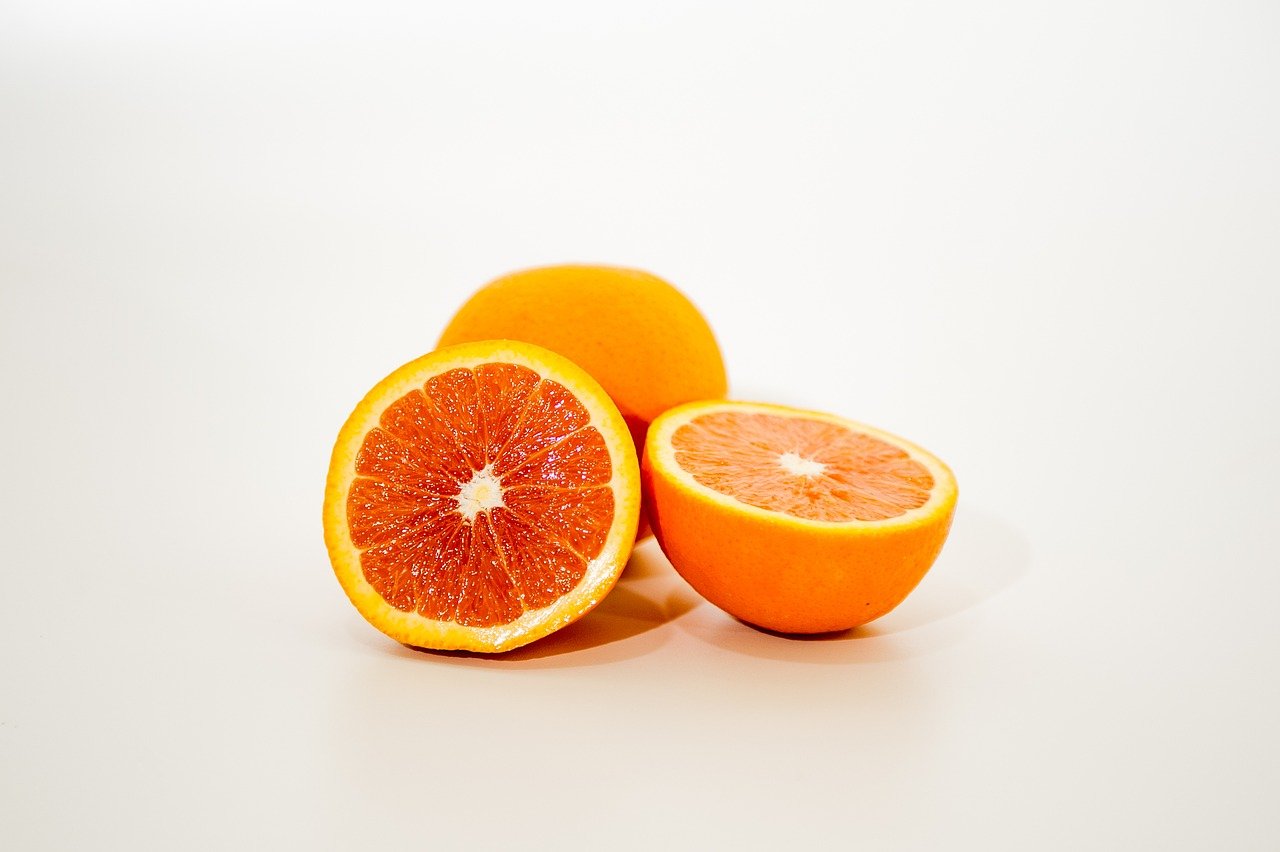
Signs Your Pet Needs a Dietary Change
As a pet owner, your furry friend’s health is likely one of your top priorities. However, how do you know when it's time to make some dietary adjustments? It’s not always as clear as it seems. Pets can't tell us when they're feeling off, so we must be vigilant and observant. A few signs can indicate that your pet's current diet isn't meeting their needs. If you notice any of the following, it might be time to reconsider what’s in their bowl.
First off, weight fluctuations can be a significant red flag. If your pet is gaining weight rapidly or losing it unexpectedly, their diet may not be suitable for their lifestyle or health condition. Maintaining a healthy weight is crucial for overall well-being, and a sudden change could indicate that their food is no longer adequate. For instance, if your cat is gaining weight despite regular playtime, it might be time to look at the calorie content of their food. Conversely, if your dog seems to be losing weight despite eating normally, you may need to increase their caloric intake or adjust the nutrient balance in their diet.
Another sign to watch for is changes in energy levels. If your once-active pup is now lounging around more than usual, or your cat seems less interested in their favorite toys, this could be a sign that their diet is lacking essential nutrients. Pets need a balanced diet to fuel their daily activities, and if they’re not getting what they need, they may become lethargic. On the flip side, if your pet is hyperactive or restless, it may be a sign that they are consuming too much of the wrong kind of food, leading to excess energy that can manifest as hyperactivity.
Don't forget about digestive issues! If your pet experiences frequent vomiting, diarrhea, or constipation, it could be a direct result of their diet. A sudden change in their stool consistency or frequency can indicate that their body is reacting poorly to their current food. In such cases, it’s essential to consult with your veterinarian to determine whether a dietary change is necessary and what type of food would be best suited for your pet’s digestive health.
Lastly, if you notice any changes in your pet's coat condition, it may be worth investigating their diet. A shiny, healthy coat is often a reflection of good nutrition. If your pet’s fur seems dull, dry, or is shedding excessively, it might be a sign that they are not getting the right balance of fatty acids or other essential nutrients. A well-balanced diet rich in omega-3 and omega-6 fatty acids can significantly improve coat health.
In summary, keeping an eye on your pet’s weight, energy levels, digestive health, and coat condition can help you identify when a dietary change is necessary. Regularly consulting with your veterinarian can also provide personalized insights tailored to your pet’s needs. Remember, a happy pet is a healthy pet, and the right diet plays a crucial role in their overall well-being!
- How often should I reevaluate my pet's diet? It's a good idea to reassess your pet's dietary needs at least once a year, or whenever you notice significant changes in their health or behavior.
- Can I switch my pet's food suddenly? It's best to transition gradually over a week to avoid digestive upset. Mix the new food with the old food, gradually increasing the new while decreasing the old.
- What should I do if my pet refuses to eat their new food? Try mixing in some of their favorite treats or consult your vet for alternatives that might be more appealing to them.
Weight Management
When it comes to our furry friends, is not just a matter of aesthetics; it’s a crucial aspect of their overall health and well-being. Just like humans, pets can struggle with their weight, and maintaining a healthy weight can significantly enhance their quality of life. Have you ever noticed your pet panting excessively after a short play session or struggling to jump onto the couch? These could be signs that their weight is affecting their mobility and energy levels. By adjusting their diet appropriately, you can help your pet shed those extra pounds or maintain a healthy weight, leading to a happier and more active lifestyle.
So, how do you go about managing your pet’s weight? First, it’s essential to understand the balance between caloric intake and physical activity. Every pet has unique needs based on their breed, age, and activity level. To give you a clearer picture, here’s a simple table that outlines the average caloric needs for various types of pets:
| Pet Type | Average Weight (lbs) | Daily Caloric Needs |
|---|---|---|
| Dog (Small) | 10-20 | 200-400 |
| Dog (Medium) | 21-50 | 400-800 |
| Dog (Large) | 51+ | 800-2000 |
| Cat | 8-12 | 200-300 |
As you can see, the caloric needs can vary significantly. This is why it’s vital to consult with your veterinarian to determine the right amount of food for your pet. They can help you create a tailored diet plan that considers your pet's specific needs. Furthermore, incorporating exercise into your pet's daily routine can make a world of difference. Regular walks, playtime, and interactive toys can keep your pet active and engaged, helping to burn off those extra calories.
Another important aspect of weight management is understanding portion control. It’s easy to overfeed our pets, especially when those pleading eyes look up at us while we eat. However, measuring out their food and sticking to recommended serving sizes can prevent unnecessary weight gain. You might also consider using a food puzzle or slow feeder to make mealtime more engaging and to help your pet eat at a healthier pace.
Lastly, be aware of treats! While it’s tempting to spoil our pets with goodies, treats should only make up a small portion of their daily caloric intake. Opt for healthier options, such as carrot sticks or small pieces of apple, which can provide a satisfying crunch without the added calories.
In summary, effective weight management for your pet involves a combination of understanding their caloric needs, ensuring they get enough exercise, practicing portion control, and being mindful of treats. With these strategies, you can help your furry companion achieve and maintain a healthy weight, leading to a longer, happier life together.
- How can I tell if my pet is overweight? Look for signs such as difficulty in breathing, inability to exercise, and the inability to feel their ribs easily.
- What should I do if my pet is underweight? Consult your veterinarian for a tailored diet plan that may include higher-calorie foods or supplements.
- How often should I exercise my pet? Aim for at least 30 minutes of exercise daily, but this can vary based on your pet's breed and age.
- Are there specific diets for weight loss in pets? Yes, many brands offer specialized weight management foods that are lower in calories but still nutritionally balanced.
Obesity in Pets
Obesity in pets is not just a cosmetic concern; it’s a serious health issue that can lead to a myriad of complications. Just like in humans, excess weight in pets can increase the risk of chronic diseases such as diabetes, heart disease, and joint problems. Imagine your furry friend struggling to jump onto the couch or becoming easily fatigued during playtime. This isn’t just a sign of aging; it could be an indicator of obesity.
One of the primary reasons pets become overweight is due to an imbalance between calorie intake and energy expenditure. Many pet owners may not realize how quickly a few extra treats or a slight increase in portion sizes can add up. It’s essential to be mindful of what we’re feeding our pets, as even seemingly harmless snacks can contribute to weight gain. For example, a single dog biscuit can contain about 30 calories, and if your pup gets one every day, that’s an additional 210 calories a week! Over time, this can significantly impact their weight.
To combat obesity, it’s crucial to implement dietary changes tailored to your pet’s specific needs. Here are some effective strategies:
- Portion Control: Measure your pet’s food and avoid free-feeding, which can lead to overeating.
- Healthy Treats: Opt for low-calorie treats or fresh fruits and vegetables that are safe for pets.
- Regular Exercise: Incorporate daily walks and playtime to help burn off those extra calories.
Monitoring your pet’s weight regularly can also help catch any weight gain early on. A simple weekly weigh-in can provide insights into whether their diet and exercise regimen is effective. If you notice that your pet is gaining weight, it may be time to consult with your veterinarian. They can help create a customized weight loss plan that includes a balanced diet and an appropriate exercise routine.
It's also important to remember that some breeds are more prone to obesity than others. Breeds like Labrador Retrievers and Cocker Spaniels are known for their love of food and can easily become overweight if not monitored closely. Understanding your pet’s breed-specific tendencies can help you make informed dietary choices that promote a healthier lifestyle.
In conclusion, addressing obesity in pets is not merely about aesthetics; it’s about enhancing their quality of life. By making conscious dietary adjustments and encouraging regular physical activity, you can help your pet live a longer, happier, and healthier life. Remember, a healthy pet is a happy pet!
Q: How can I tell if my pet is overweight?
A: You can assess your pet's weight by feeling their ribs. If you can’t feel them easily, your pet may be overweight. Additionally, consult your veterinarian for a professional evaluation.
Q: What are some healthy snacks for my pet?
A: Fresh fruits like apples (without seeds), carrots, and green beans are great low-calorie snacks for pets. Always check with your vet before introducing new foods.
Q: How much exercise does my pet need?
A: Generally, pets should get at least 30 minutes of exercise daily, but this can vary based on breed, age, and health. Consult with your veterinarian for a tailored exercise plan.
Underweight Concerns
When it comes to our furry friends, being underweight is just as concerning as being overweight. An underweight pet can face a myriad of health issues that can affect their quality of life and longevity. Just like humans, pets require a balanced diet that meets their specific energy and nutritional needs. If you notice that your pet is looking a bit too skinny or has lost weight unexpectedly, it’s essential to take action. After all, a healthy pet is a happy pet!
Underweight pets often struggle to maintain their energy levels, which can lead to lethargy and a lack of enthusiasm for playtime or walks. This can be particularly concerning for younger pets who are still growing and developing. A well-balanced diet is crucial for their growth, and if they’re not getting enough calories, they may not reach their full potential. Think of it like fueling a car; without the right fuel, the engine won’t run smoothly. In the same way, your pet needs the right nutrients to thrive.
So, how can you tell if your pet is underweight? Here are a few signs to look out for:
- Visible ribs and spine: If you can easily see or feel your pet's ribs without applying pressure, it’s a sign they may be underweight.
- Loss of muscle mass: An underweight pet may have a noticeable lack of muscle tone, particularly around the shoulders and hips.
- Low energy levels: If your pet seems more tired than usual or is less active, it could indicate they’re not getting enough calories.
If you suspect that your pet is underweight, it’s vital to consult with your veterinarian. They can help determine the underlying causes, which may include health issues, dental problems, or simply a picky eater. Once you have a clear understanding, you can work together to create a tailored feeding plan that addresses your pet's unique needs.
In many cases, increasing the caloric intake with high-quality, nutrient-dense foods can make a significant difference. This might include options like:
| Food Type | Benefits |
|---|---|
| High-Protein Kibble | Supports muscle growth and energy |
| Canned Wet Food | Higher moisture content and palatability |
| Supplemental Treats | Can be used to add extra calories |
Additionally, consider incorporating small, frequent meals instead of one or two large meals. This can help improve their appetite and make it easier for them to consume the necessary calories throughout the day. Just remember, any dietary changes should be made gradually to avoid upsetting your pet's stomach.
In conclusion, keeping an eye on your pet's weight is crucial for their overall health. If you notice any signs of being underweight, don’t hesitate to reach out to your vet. With the right approach, you can help your pet achieve a healthy weight and enjoy a more vibrant, active life.
Q: What should I do if my pet is underweight?
A: Consult your veterinarian to determine the underlying cause and create a tailored feeding plan.
Q: How can I increase my pet’s appetite?
A: Consider offering high-quality, palatable foods and feeding smaller, more frequent meals.
Q: Are there specific foods I should avoid for underweight pets?
A: Avoid low-calorie diets and foods that are primarily fillers without substantial nutritional value.
Life Stage Considerations
When it comes to our furry friends, one size does not fit all, especially regarding their diets. Just like humans, pets go through various life stages, and their nutritional needs change significantly throughout their lives. For instance, a playful puppy requires a different set of nutrients compared to a wise old dog. Understanding these differences is crucial for pet owners who want to ensure their pets lead healthy, vibrant lives.
During the puppy stage, which typically lasts until they are about one year old, pets are in a rapid growth phase. They need a diet rich in proteins and fats to support their developing muscles and bones. A high-quality puppy food that is specifically formulated for growing dogs is essential. This stage is akin to a teenager's growth spurt; they need the right fuel to grow strong and healthy. On the other hand, as pets transition into adulthood, their metabolism slows down, and their nutritional needs shift. Adult dogs generally require a balanced diet that maintains their health without promoting excess weight gain.
As pets age into their senior years, usually around seven years old for many breeds, their diets should adapt once again. Senior pets often benefit from diets lower in calories but higher in fiber to aid digestion. Additionally, they may require special nutrients like glucosamine to support joint health. Think of it as a retirement plan for their bodies—just like we need to adjust our diets as we age, so do our pets.
| Life Stage | Nutritional Focus | Key Considerations |
|---|---|---|
| Puppy | High protein and fat | Supports growth and development |
| Adult | Balanced nutrition | Maintains weight and health |
| Senior | Lower calories, higher fiber | Supports digestion and joint health |
It's also important to note that individual pets may have specific dietary needs based on their breed, size, and health issues. For example, large breed dogs might require special formulations to prevent joint problems, while small breeds may need a diet that caters to their unique metabolic rates. Regular veterinary check-ups can help identify these specific needs, ensuring that your pet's diet is always tailored to their current life stage.
In conclusion, understanding the dietary needs of your pet at each life stage is not just beneficial; it’s essential. By providing the right nutrition, you can help your pet thrive through every phase of life, ensuring they have the energy to play, explore, and enjoy their time with you.
- How often should I change my pet's diet? It's best to consult your veterinarian, but generally, you should adjust your pet's diet as they transition between life stages.
- Can I mix different types of pet food? Mixing foods can be done, but it's important to ensure that the combination meets all of your pet's nutritional needs.
- What are the signs my pet needs a dietary change? Look for changes in weight, energy levels, or digestive issues, and consult your vet to determine the best course of action.
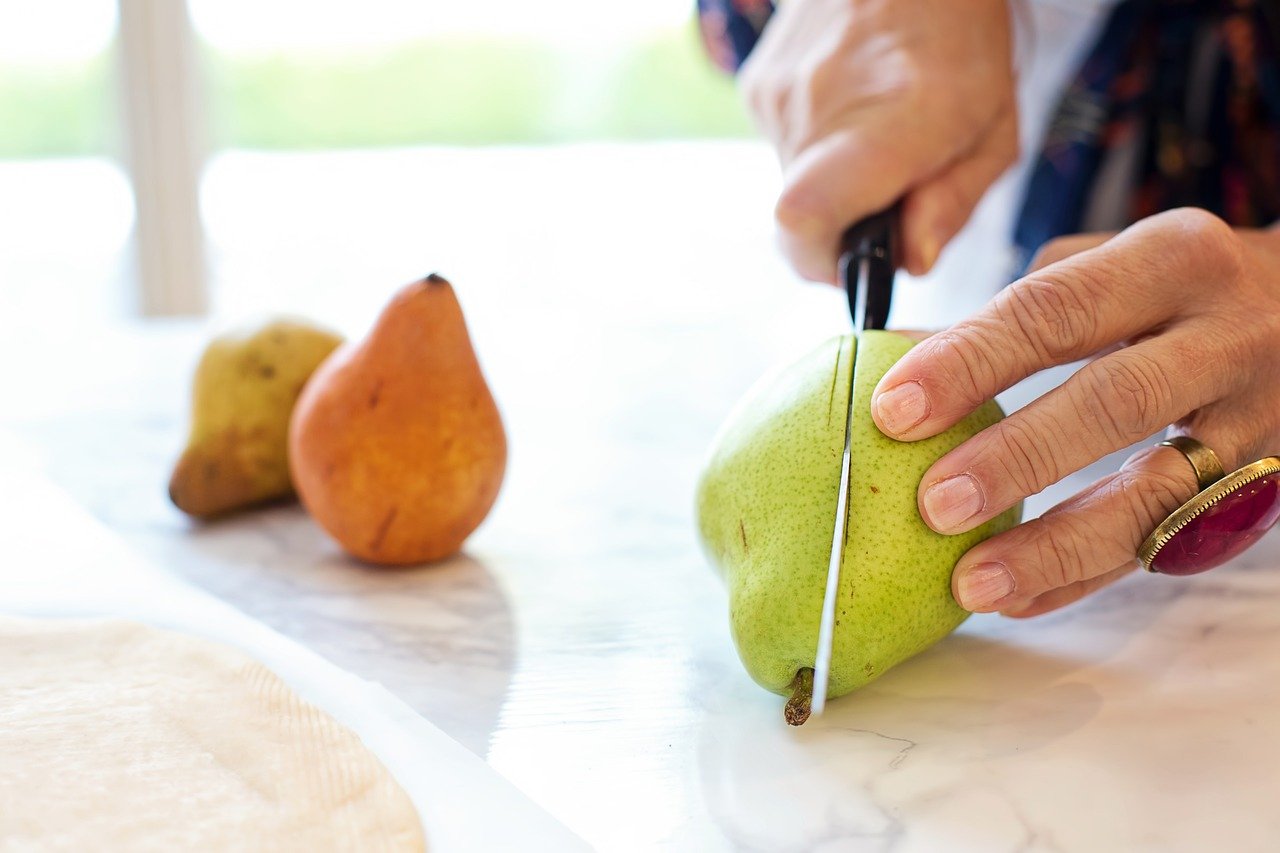
Common Dietary Myths
When it comes to pet nutrition, misinformation can spread like wildfire, leading many pet owners down a path of confusion and concern. It's essential to separate fact from fiction, especially when it comes to your furry friends' diets. One common myth is the belief that all pets should be on a grain-free diet. Many people assume that grains are harmful or that they contribute to obesity and allergies. However, this isn't the case for every pet. In fact, grains can provide essential nutrients and energy for many dogs and cats. It's crucial to understand that the dietary needs of pets vary significantly based on their individual health, lifestyle, and breed.
Another popular misconception is that raw diets are the best option for all pets. While some pet owners swear by raw feeding, it's essential to weigh the pros and cons carefully. Raw diets can be beneficial, but they also come with risks, such as bacterial contamination and nutritional imbalances. Before making any drastic changes to your pet's diet, it's wise to consult with a veterinarian who can provide tailored advice based on your pet's unique needs.
Additionally, there's a widespread belief that homemade diets are always better than commercial pet foods. While preparing meals at home can be a great way to control ingredients, it can also lead to nutritional deficiencies if not done correctly. Many commercial pet foods are formulated to provide a balanced diet that meets all your pet's nutritional requirements. Therefore, before jumping on the homemade bandwagon, consider the time, effort, and knowledge required to create a balanced diet for your pet.
To further illustrate these myths, let’s look at a comparison table:
| Myth | Fact |
|---|---|
| All pets need a grain-free diet. | Not all pets require a grain-free diet; grains can be a healthy part of their nutrition. |
| Raw diets are the best for pets. | Raw diets have benefits and risks; consult a vet before making changes. |
| Homemade diets are always superior. | Homemade diets can lead to deficiencies; commercial foods are often balanced. |
In conclusion, debunking these dietary myths is crucial for ensuring your pet receives the best possible nutrition. Always remember that what works for one pet may not work for another. The key is to observe your pet's health and well-being and consult with a veterinarian to tailor their diet to their specific needs.
Q: Is it safe to switch my pet to a grain-free diet?
A: Not necessarily. It's important to consult with your veterinarian to determine if a grain-free diet is appropriate for your pet's specific health needs.
Q: What are the risks of feeding my pet a raw diet?
A: Raw diets can pose risks such as bacterial contamination and nutritional imbalances. Always discuss with a vet before making this switch.
Q: Can I create a balanced homemade diet for my pet?
A: Yes, but it requires careful planning and knowledge of pet nutrition. It's often easier to rely on commercially prepared foods that meet nutritional standards.
Grain-Free Diets
When it comes to our furry companions, the topic of often stirs up a whirlwind of opinions. Many pet owners have jumped on the bandwagon, believing that eliminating grains from their pets' meals is the golden ticket to better health. But is this really the case? The truth is, while some pets may benefit from a grain-free diet, it’s not a one-size-fits-all solution. Understanding your pet's unique nutritional needs is essential before making any drastic changes.
Grains such as wheat, corn, and rice have long been staples in pet food, providing a source of carbohydrates and essential nutrients. However, the surge in grain-free diets has been fueled by the belief that grains are linked to allergies and digestive issues in pets. While it’s true that some pets may have sensitivities to specific grains, it’s important to consider that not all grains are harmful. In fact, grains can offer valuable nutrients like fiber, which aids in digestion, and proteins that contribute to overall health.
Before jumping to conclusions about grains, it's wise to consult with a veterinarian. They can help determine if your pet truly needs a grain-free diet or if it’s simply a matter of finding the right balance in their current food. For instance, if your pet is experiencing digestive issues, it could be due to other ingredients in their food rather than the grains themselves. In such cases, switching to a different protein source or adjusting the overall diet may be more effective.
Moreover, it's crucial to understand that grain-free diets often substitute grains with alternative ingredients like peas, potatoes, or lentils. While these options can be beneficial, they can also lead to nutritional imbalances if not properly formulated. For example, some grain-free diets may be higher in carbohydrates than traditional diets, leading to potential weight gain and other health issues. Hence, a careful evaluation of the diet's overall composition is necessary.
To put things into perspective, let’s look at a quick comparison of traditional versus grain-free diets:
| Aspect | Traditional Diet | Grain-Free Diet |
|---|---|---|
| Carbohydrate Source | Includes grains | Uses alternative ingredients |
| Nutritional Balance | Well-rounded with grains | Risk of imbalance if poorly formulated |
| Digestive Health | Fiber from grains | Fiber from alternatives |
In conclusion, while grain-free diets may seem appealing, it’s essential to approach them with caution. Always keep your pet's specific health needs in mind and consult with a professional before making any significant dietary changes. Remember, every pet is unique, and what works wonders for one might not suit another!
- Is a grain-free diet better for all pets?
No, not all pets require a grain-free diet. It depends on their individual health needs and sensitivities. - What are the signs my pet might need a dietary change?
Signs include weight changes, digestive issues, and a lack of energy. Always consult your veterinarian for advice. - Can grains be beneficial for pets?
Yes, grains can provide essential nutrients and fiber, which are important for digestive health.
Raw Diets
The trend of feeding pets a raw diet has gained significant traction among pet owners in recent years. Advocates argue that a diet rich in raw meat, bones, fruits, and vegetables mimics what wild animals eat, potentially leading to healthier, more energetic pets. However, before you jump on the raw diet bandwagon, it’s crucial to understand both the benefits and the risks associated with such a drastic dietary change.
One of the primary reasons many pet owners consider a raw diet is the belief that it can lead to improved digestion and a shinier coat. Indeed, some pets may experience a boost in energy levels and overall vitality when switched to a raw diet. The natural enzymes present in raw foods are thought to aid in digestion, allowing pets to absorb nutrients more efficiently. Additionally, the absence of artificial preservatives and fillers found in many commercial pet foods can be appealing to those looking to provide their furry friends with a more wholesome diet.
However, it’s essential to approach raw diets with caution. One of the significant concerns is the risk of bacterial contamination. Raw meat can harbor harmful bacteria like Salmonella and E. coli, which can pose serious health risks not only to pets but also to humans in the household. Proper handling and preparation are crucial to mitigate these risks, and pet owners must be diligent about cleanliness when preparing raw meals.
Another critical factor to consider is the nutritional balance. While a raw diet may include a variety of meats and vegetables, it’s vital to ensure that it meets all of your pet’s nutritional needs. Pets require a delicate balance of proteins, fats, vitamins, and minerals to thrive. A poorly planned raw diet can lead to deficiencies or imbalances, potentially causing long-term health issues. Consulting with a veterinarian or a pet nutritionist can provide guidance on how to formulate a balanced raw diet tailored to your pet's specific needs.
To help illustrate the differences in raw diets, here’s a simple comparison table:
| Aspect | Raw Diet | Commercial Diet |
|---|---|---|
| Nutritional Balance | Can be tailored but risk of imbalance | Formulated to meet specific needs |
| Preparation | Requires careful handling | Ready to serve |
| Bacterial Risks | Higher risk of contamination | Lower risk due to processing |
| Cost | Can be more expensive | Varies widely |
In conclusion, while a raw diet can offer certain benefits, it’s essential to weigh these against the potential risks. If you’re considering making the switch, do your research, consult with professionals, and proceed with caution. After all, your pet's health and well-being should always be the top priority!
- Is a raw diet suitable for all pets? Not necessarily. Each pet has unique nutritional needs, and it’s important to consult with a veterinarian before making any significant dietary changes.
- What are the risks of feeding a raw diet? The primary risks include bacterial contamination and nutritional imbalances if not properly managed.
- Can I mix raw food with commercial pet food? Mixing diets can be complicated and may lead to digestive issues. It’s best to transition gradually and seek professional advice.
- How do I ensure my pet's raw diet is balanced? Work with a veterinarian or a pet nutritionist to create a diet plan that meets all of your pet's nutritional requirements.
Frequently Asked Questions
- Why is regular dietary adjustment important for my pet?
Regular dietary adjustments are crucial because pets, much like humans, go through various life stages and changes in activity levels. Their nutritional needs evolve, and adapting their diet ensures they receive the right balance of nutrients to maintain optimal health and prevent potential health issues.
- How can I tell if my pet needs a dietary change?
Watch for signs such as weight gain or loss, changes in energy levels, or alterations in their coat condition. If your pet seems lethargic or overly energetic, or if they have digestive issues, it might be time to reassess their diet.
- What are the risks of obesity in pets?
Obesity in pets can lead to serious health complications, including diabetes, joint problems, and heart disease. Maintaining a healthy weight through proper dietary adjustments can significantly enhance your pet's quality of life and longevity.
- How do I help my underweight pet?
If your pet is underweight, it's essential to gradually increase their caloric intake and ensure they receive the right nutrients. Consulting with a veterinarian can help you create a tailored feeding plan that supports healthy weight gain.
- Are grain-free diets better for all pets?
Not necessarily! While grain-free diets can be beneficial for some pets with specific allergies or sensitivities, they are not universally superior. It's vital to understand your pet's individual dietary needs before making such changes.
- What should I consider before switching to a raw diet for my pet?
Switching to a raw diet can have benefits, but it also comes with risks such as nutritional imbalances and exposure to harmful bacteria. It’s essential to research thoroughly and consult with a veterinarian to ensure it’s the right choice for your pet.

